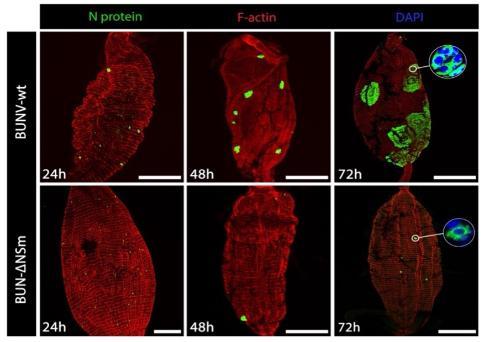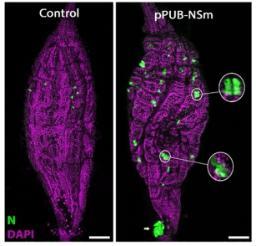New research reveals the crucial role of NSm protein for bunyavirus transmission between vertebrate and mosquito hosts
Published: 24 January 2025
New research from the CVR reveals how the NSm protein helps bunyaviruses spread by mosquitoes. NSm enables the virus to bypass the midgut barrier, making transmission to humans and animals possible.
Bunyaviruses are a diverse group of viruses that infect animals, plants, and insects, with some posing serious threats to human health by causing diseases like Rift Valley fever and Crimean-Congo haemorrhagic fever. Some of these bunyaviruses are spread between animals and humans through bites from blood-feeding arthropods, like mosquitoes. However, not all bunyaviruses can spread this way, and scientists do not yet understand why.
While all bunyaviruses possess a similar genome structure, some viruses also encode the non-structural NSm protein, whose function remained unknown, being dispensable for virus replication in mammalian cells.
To gain insights into the function of NSm, the team of researchers led by Dr Emilie Pondeville performed computational analysis of the presence or absence of NSm across viruses from the Bunyavirales order. Interestingly, this revealed that NSm is only present in bunyaviruses transmitted by arthropods, suggesting a role of NSm in virus transmission by arthropod vectors.
To further understand the function of NSm, the authors studied the Bunyamwera virus (BUNV) and its interaction with Aedes aegypti mosquitoes, which can transmit the virus. They found that NSm is not necessary for the virus to multiply in mosquito cells. However, they demonstrated that mosquitoes infected with BUNV lacking NSm had significantly lower midgut infection rates and infection did not migrate further, compared to mosquitoes infected with the wild type virus. To successfully infect an arthropod vector, an arbovirus overcomes different barriers. Initially, in the first few hours after the infectious blood meal, the virus invades and replicates in a few epithelial midgut cells. The virus then spreads from infected cells to uninfected ones within the midgut epithelium, before the virus finally escapes from the midgut.

Researchers showed that NSm is crucial for the virus to spread inside a mosquito after it has taken an infected blood meal. More specifically, NSm helps the virus move from cell to cell to form large focus of infection and escape from the mosquito’s midgut, a part of the digestive system that can act as a barrier to infection. Interestingly, if this barrier is bypassed by directly injecting the virus into other parts of the mosquito, NSm is no longer needed for the virus to spread to other areas, like the salivary glands.

NSm is specifically required for virus cell-to-cell spread in the mosquito midgut and is therefore an essential determinant for successful infection and dissemination in the mosquito vector.
Analysis showed that NSm is present in bunyaviruses belonging to only a few viral genera and which are spread across phylogenetically distinct families supporting that NSm acquisition is the result of convergent evolution as these viruses were adapting to similar environments and selective pressures. Since NSm is present in arbo-bunyaviruses only, one of the possible explanations is that these viruses have acquired NSm to overcome the insect vector midgut barrier after oral infection.
This discovery highlights an important evolutionary step that enables certain bunyaviruses to spread between mosquitoes and animals or humans.
To dive deeper into this exciting discovery, the full research article is available here.
First published: 24 January 2025
<< News

